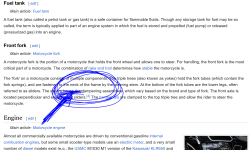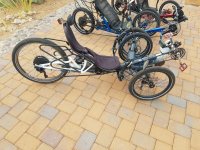DogDipstick
100 kW
Which one? I have built three. All broke 60mph. some stronger than bicycle parts, but mostly bicycle parts. Working on the fourth. Working on the fifth too. They will be cromotor or LR big block bikes, ironhorses, with Marzochi and Risse, hammersmiths, and good brks ( magurs).Can your share some photos of your 60 mph bike? Please?
My true-DWlink Ironhorse bicycle ( is the one that cracked again, 50K miles and six years as an ebike) ... the... , Super73, the Eleek bomber.
Here is one. ... and ... hasnt happened to this bike.. but... ironically, this chassis is notorious for cracking the neck. Super73 has replaced thousands of frames after the neck broke. My white bike? I beat on it. I got thread about its build. On here... its got a couple thousand watt hours on it. I try to build at least 2kWh bikes.. no fun if not. My white bike has full write ups here. the others dont. no one cares what I built lol. I'll post a bike here, spent a year working on it... with zero comment sand so after a while... so I quit. I do post them to my DIY ebike facbook groups though since i got a good reputation there as a builder.
Im sorry I dont have any pictures of the Eleek. I do have a vid of it at 150mph on its 273 on the stand ballooning a tire. Lol. That had magura brakes and a brnd new World rally Cup RS boxxer... god what a fork. Shimano tensioners and good chainrings. all the bike parts were high end.
ok. Well a 750wh pack might be fun.. but not " as much fun"... 2kWh if more funner betterer greater than etc.
Chalo: The " neck " of a bicycle ( the image you get when you type that into an "internet search engine") is the part the fork attaches to. This is true ( read: not false
Type "bicycle neck " into Google and you will see about a thousand images about what I speak of. also referenced on the wiki page under " FRAME" .. as shown in the snippet I provide. I understand this might not be common vernacular wherst you are from, but I assure you it is common in the area I am from.
If you say " Motorcycle neck" or " bicycle neck" from where I live, the people know right away what part of the MC or bicycle you are speaking of. It is the part that the fork tube is bolted to. The frontmost part of the frame... the part that hold the steering bearing(s) and their races.
Attachments
-
 334063637_226274769888215_489302032811716636_n.jpg276.8 KB · Views: 23
334063637_226274769888215_489302032811716636_n.jpg276.8 KB · Views: 23 -
 334226461_1253340125533947_8716175986449955555_n.jpg471.9 KB · Views: 17
334226461_1253340125533947_8716175986449955555_n.jpg471.9 KB · Views: 17 -
 334172492_735081537970206_1090949716368987164_n.jpg678.3 KB · Views: 15
334172492_735081537970206_1090949716368987164_n.jpg678.3 KB · Views: 15 -
 172184626_4305866409443655_7152223281040371168_n.jpg62 KB · Views: 21
172184626_4305866409443655_7152223281040371168_n.jpg62 KB · Views: 21 -
 302439367_5864650860231861_8155224109001717448_n.jpg1.1 MB · Views: 22
302439367_5864650860231861_8155224109001717448_n.jpg1.1 MB · Views: 22 -
 Capture.PNG255.9 KB · Views: 23
Capture.PNG255.9 KB · Views: 23






